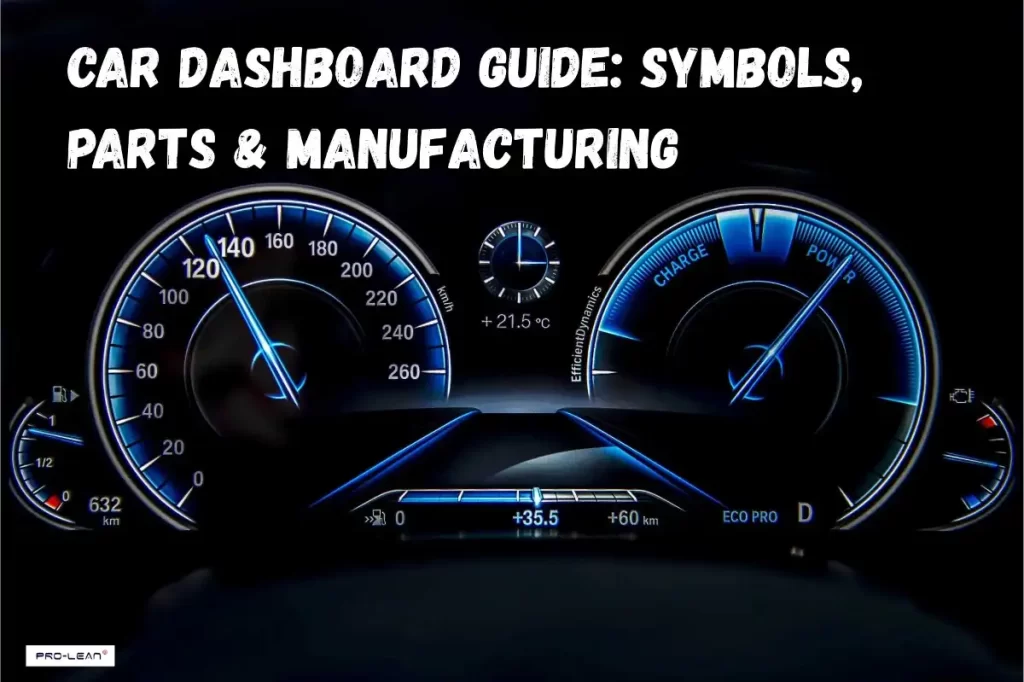
Car Dashboard Guide: Symbols & Parts
The dashboard is like the main control panel of any car. It shows important things, including how fast you’re driving and how much gas you have, making driving safe and hassle-free.
Modern car dashboards mix old and new ideas, using touchscreens and the usual gauges. If you want to ensure everything on the dashboard works perfectly and looks good, consider ProleanTech.
As leading automotive manufacturers, we use special ways to build every part precisely. Our experts use machines to cut and shape material optimally, so the dashboard parts fit just right. This helps car companies make dashboards that work well and look aesthetic.
This guide will help you get insights into symbols, parts, and manufacturing expertise that powers the modern dashboard. You’ll also learn how ProleanTech crafts high-precision dashboard components through advanced CNC machining and injection molding.
So, let’s dive straight into the blog:
What is a Car Dashboard?
Before diving further, let’s have a look at the picture of a labelled car dashboard:
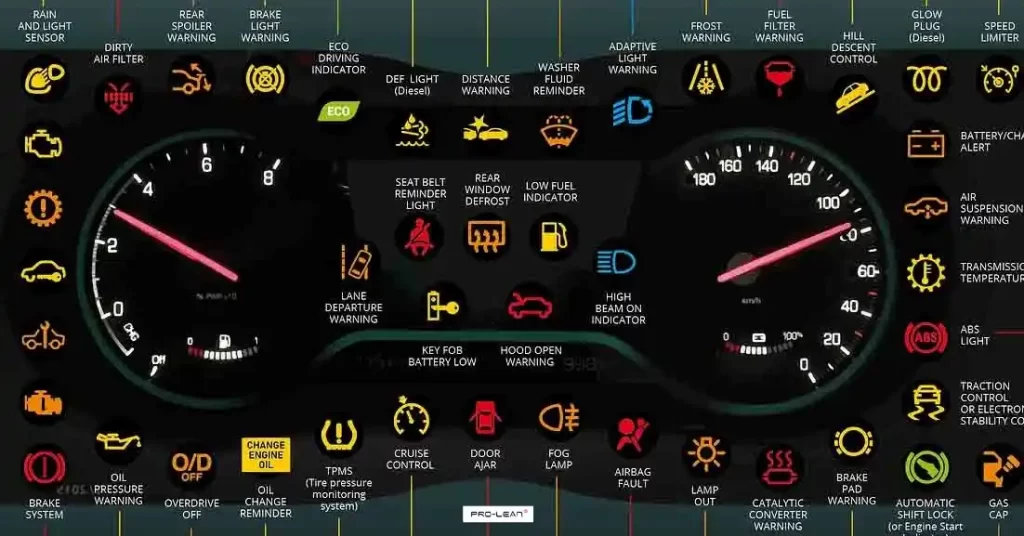
Car Dashboard Explained
The car dashboard is the main area in front of the driver. It shows essential things and has buttons and controls. The dashboard car label helps drivers interact with their vehicle safely and effectively. Essential controls and indicators are grouped here.
You’ll typically find labels for the speedometer, which shows your driving speed, and the tachometer, indicating engine revolutions per minute. Warning lights, such as those for low fuel or engine issues, are also clear signs for quick recognition.
These labeled components provide crucial information at a glance, enhancing driving awareness and safety. Familiarizing yourself with each car’s dashboard labelled elements is key to understanding your car’s status.
Car Dashboard Diagram
A car dashboard diagram visually represents the layout of the instrument panel. It typically labels key components like the speedometer, tachometer, fuel gauge, and various warning lights.
These diagrams help drivers quickly identify and understand the information presented, contributing to safer vehicle operation. They can also be helpful in learning about car functions.
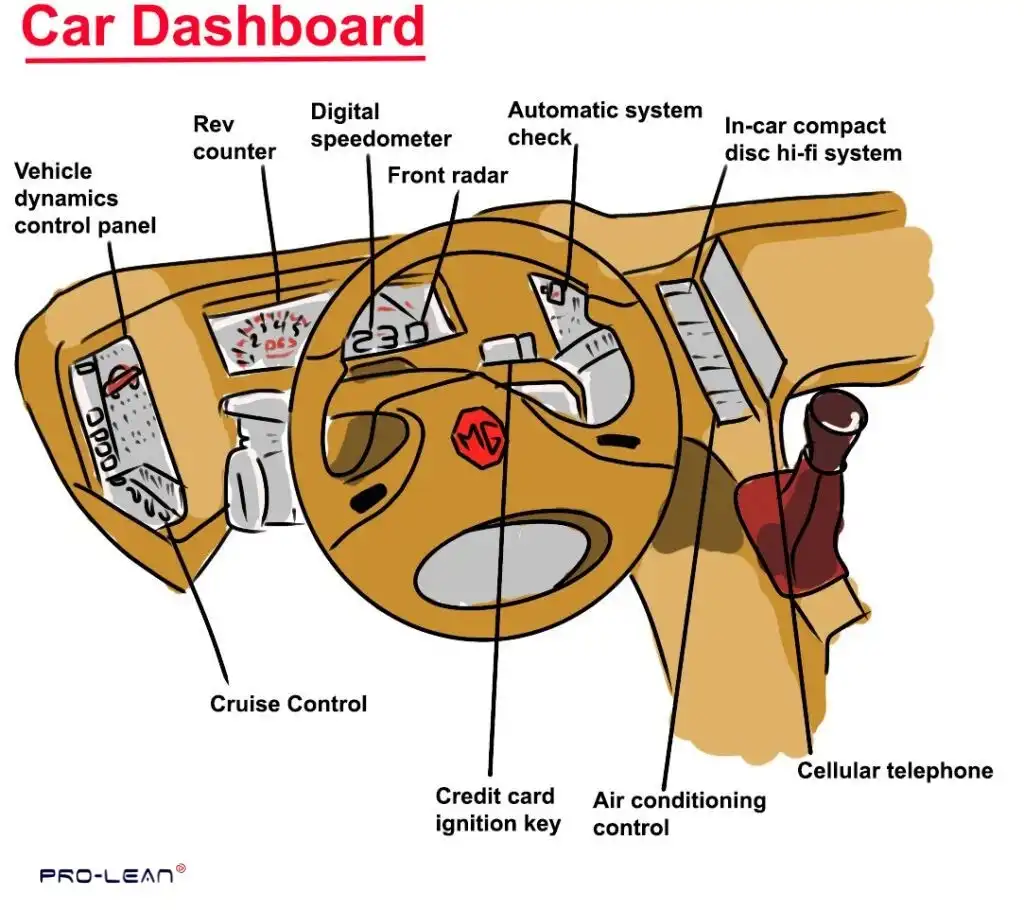
Labeled Car Dashboard Illustration
Parts of a Car Dashboard
The dashboard consists of numerous components working together to provide information and control. Each part serves a specific function essential for vehicle operation and driver convenience.
Here’s a breakdown of the main parts of a car:
Instrument Cluster
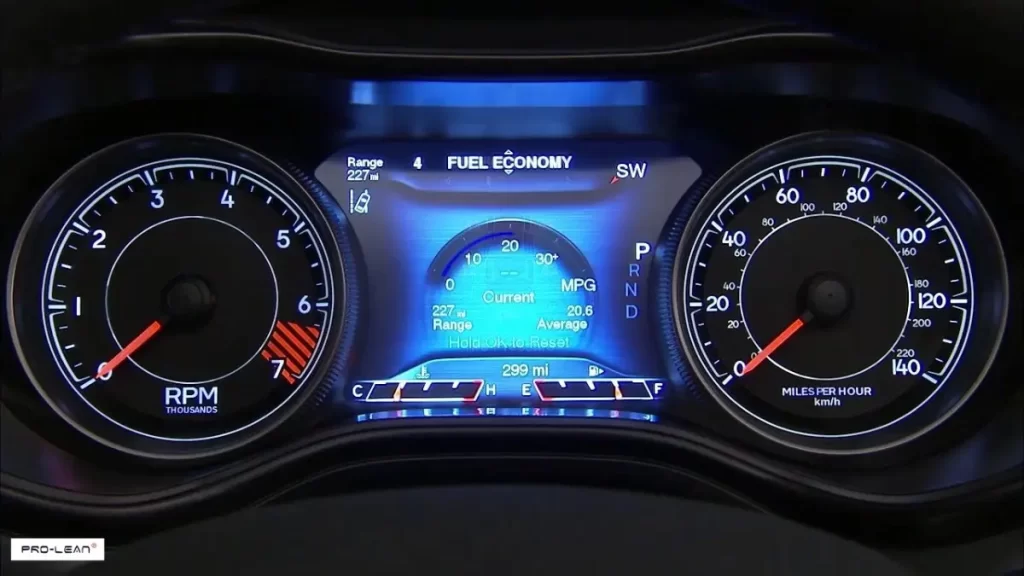
Instrument Cluster
The instrument cluster is a part of the car dashboard, and shows the required information when driving the main display in your car. It has a gauge to check speed and engine power, as well as lights that tell you what the problem is.
This instrument cluster display helps to know how fast you are going, how hard the engine is working, or if there are any other problems with the car. The speedometer tells you the speed of your car, and the tachometer shows how fast the engine is running.
There are also gauges for fuel and temperature, and lights that alert you if something requires your attention.
Center Console
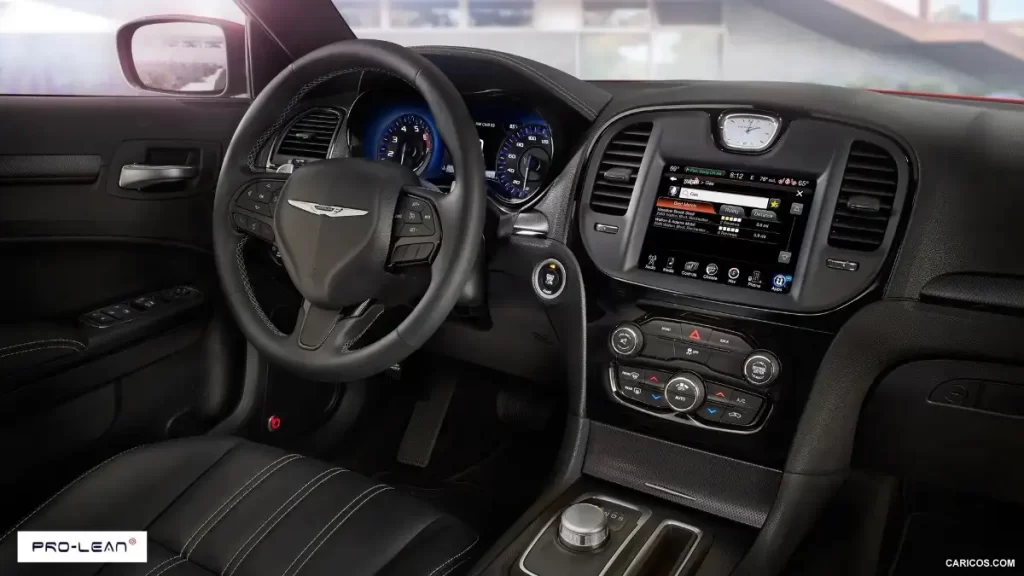
Car Interior Center Console View
The center console helps manage climate control systems and allows you to have fun while driving. It is placed in the center so that the driver can easily access it. Modern consoles often include a touchscreen with integrated functions.
The entertainment system ranges from basic radio units to advanced centers. Whereas, Climate control manages:
- Temperature
- Fan speed
- Air distribution.
Control Panels
Control panels contain switches and buttons for other functions. The control panel includes:
- Window controls
- Door lock switches
- Headlights
- Windshield wipers
- Hazard lights
Their ergonomic placement ensures easy access while driving.
Storage Compartments
Most dashboards also have storage areas for the required dashboard items. Looking at the car dashboard pics, you can often see these easy compartments. This includes:
- Glove coaches for the safe storage of required documents
- Small cans to keep sunglasses or smartphones
Now that we know what a car dashboard is and its essential parts, let’s understand the car dashboard signs.
Try Prolean Now!
Car Dashboard Signs
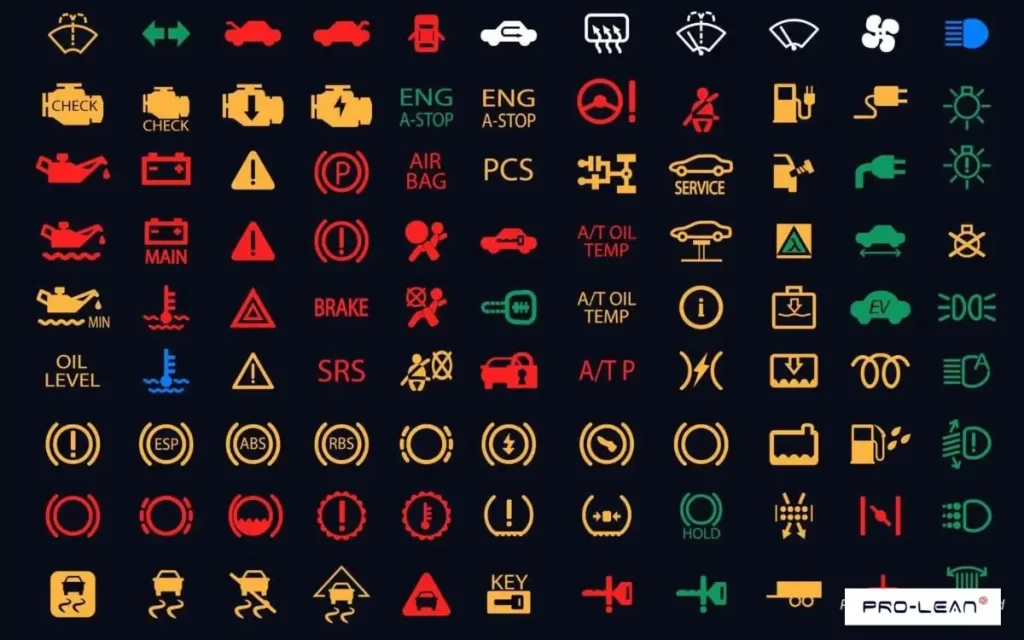
Assorted Car Dashboard Warning Symbols
Car dashboard signals are enlightened symbols that provide necessary information about your vehicle’s status and potential issues.
Use different colors to indicate the severity of dashboard warning lights:
- Red: Serious issue requiring immediate attention
- Amber/Yellow: Caution needed, service required soon
- Green/Blue: Informational, systems functioning normally
Critical Warning Lights
These red indicators demand immediate attention. Ignoring them could result in severe damage or safety hazards.
| Symbol | Name | Meaning |
| Show Image | Oil Pressure Warning | Engine oil pressure is too low; stop immediately |
| Show Image | Engine Temperature Warning | The engine is overheating; pull over safely |
| Show Image | Battery/Charging Alert | The electrical system is not charging properly |
| Show Image | Brake System Warning | Issue with brakes or brake fluid level |
The oil pressure warning indicates dangerously low oil pressure. This requires immediate engine shutdown to prevent damage. At ProleanTech, we manufacture precision components that help prevent such failures.
Engine temperature warnings signal potential cooling system failures. Continuing to drive risks severe engine damage. The battery alert indicates charging system problems that could lead to stalling.
Important Caution Indicators
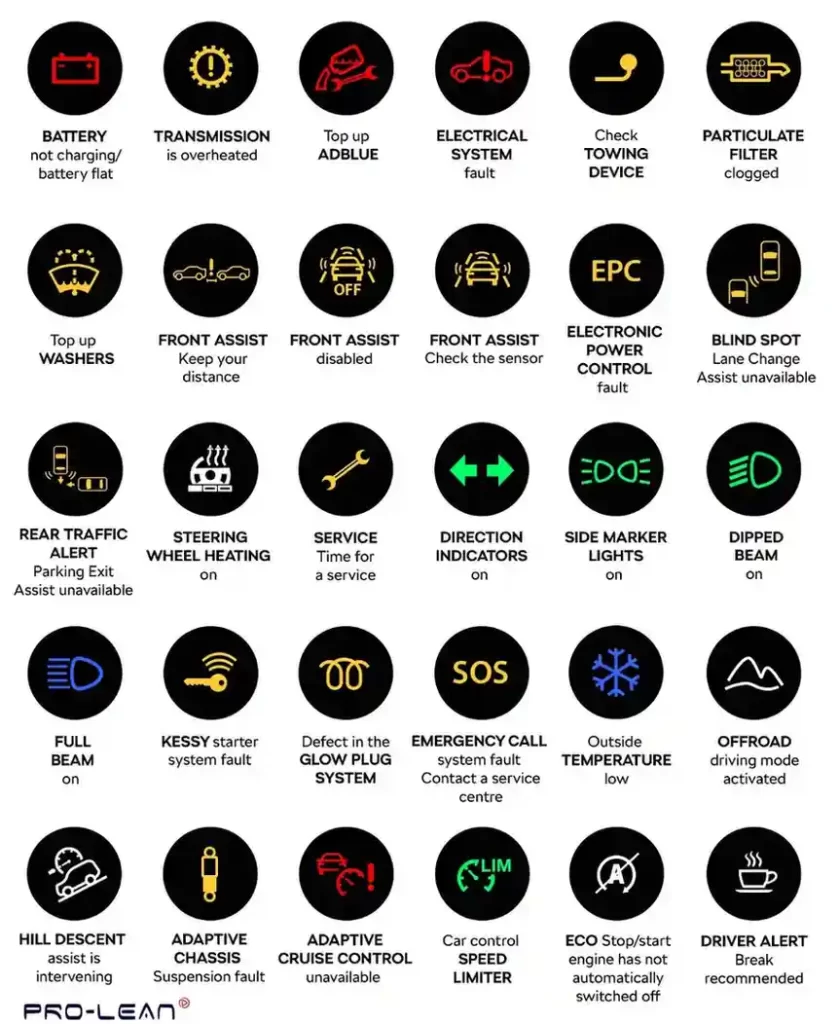
Common Car Dashboard Warnings
Yellow or amber lights mean there’s a problem that needs your attention soon. You don’t need to fix it immediately, but you should get it checked out soon.
The check engine light means problems with the engine or how the car handles the exhaust. It could be a minor problem or a big problem that needs to be figured out. Today’s cars keep codes for these problems, and you can use innovative tools to see what they are.
There can also be some issues with the anti-lock brakes if you see the ABS lights. Regular brakes will still work, but they can stop immediately in an emergency. However, they might not be as good. This system supports your wheels so they do not lock up when you brake hard.
The tire pressure light comes on if your tires have enough air. As a result, your car will use more gas, making your tires wear out faster. Keeping the right air in your tires is essential for safety and how your car drives.
Informational Indicators
Green and blue lights typically provide status information. They show which systems are currently active or engaged.
These include turn signals, fog lights, high beams, and cruise control. They confirm system activation and remind drivers which features are engaged, preventing accidental extended use of certain functions.
Eco mode indicators show when efficiency-oriented driving modes are active. These modes modify response and transmission behavior. They help maximize fuel economy during regular driving.
Different Types of Car Dashboards
Car dashboards have evolved significantly over the years. Modern vehicles offer various dashboard styles to meet different needs and preferences.
Analog Dashboards
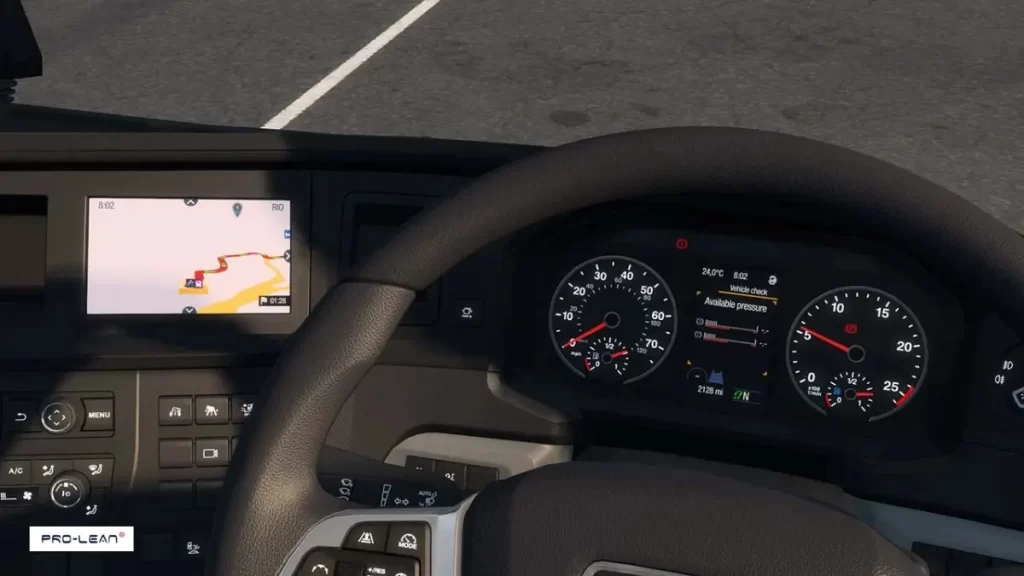
Analog Dashboard
Traditional analog dashboards use physical gauges with needles. They display information through mechanical or electromechanical means. Many drivers prefer their classic look and instant readability.
Analog gauges provide visual feedback through needle position. They work independently of complex electronic systems. This makes them reliable even when other systems fail.
Many manufacturers combine analog gauges with small digital displays. This hybrid approach offers a traditional appearance with additional information capacity. Sports cars often feature prominent analog tachometers for performance driving.
Digital Dashboards
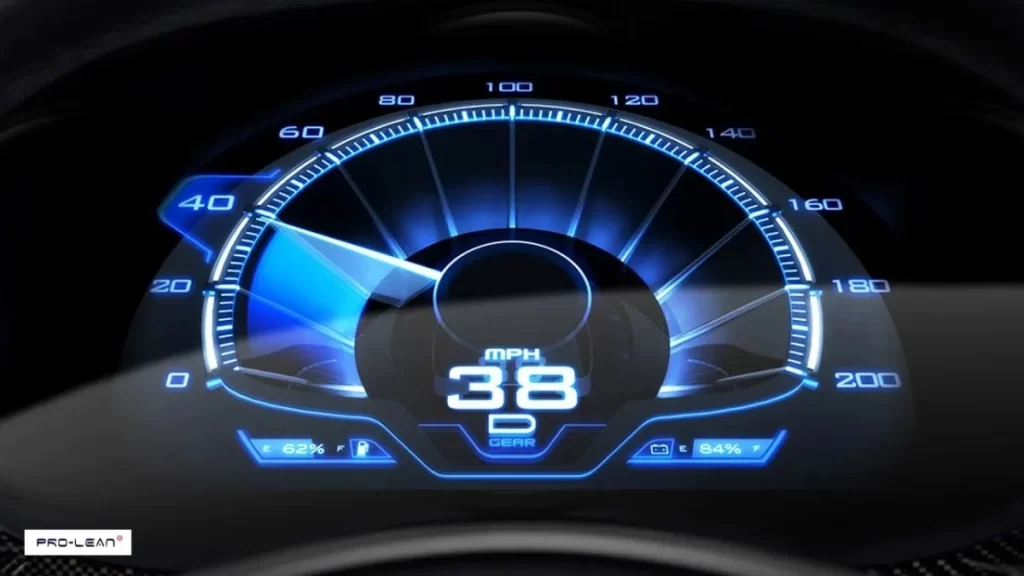
Modern Digital Car Dashboard Display
Digital dashboards use the screen to display all information electronically. They provide adaptable layouts and additional information beyond the physical gauge. They develop with better resolution and functionality.
The early digital dashboard used the LED or LCD segment. Modern versions have a high-resolution color screen. They can be compatible with various driving modes and user preferences.
Digital displays allow for the emphasis of animation and essential information. They can prioritize various data based on current circumstances.
At ProleanTech, we provide manufacturing solutions for precision components used in display systems. Want to know more about manufacturing precision components? Check out our guide to EDM vs. CNC: Find the Best Manufacturing Method for insights into production techniques.
Head-Up Displays (HUD)
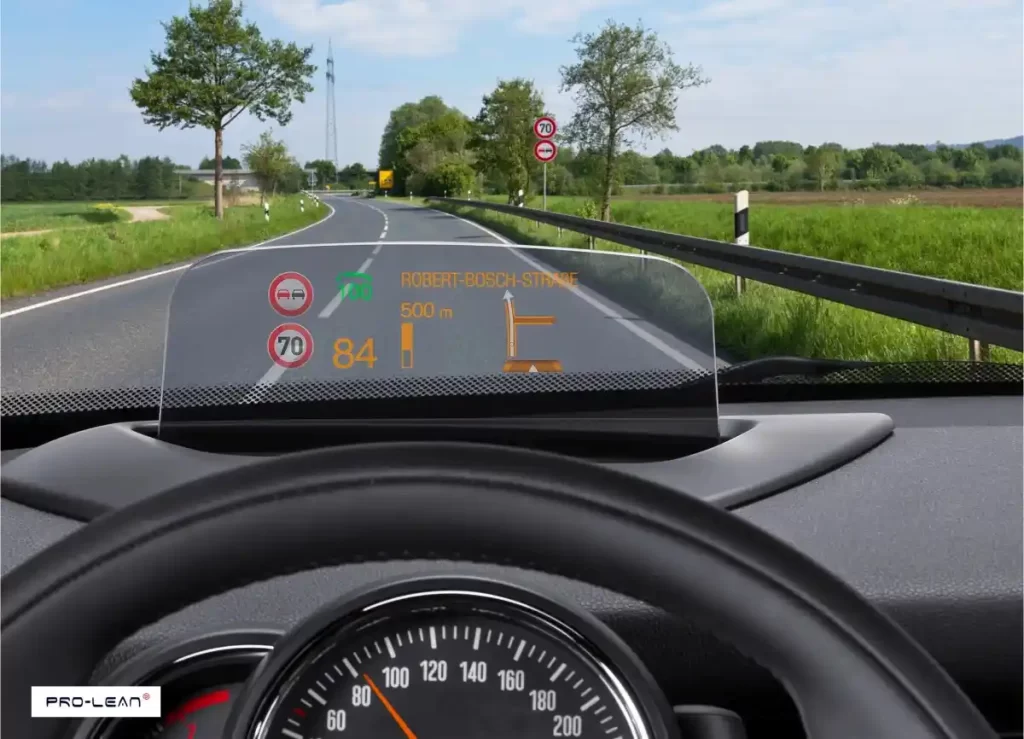
Bosch Combiner Head-up Display
HUDs give information on the windshield or a transparent screen. This allows drivers to see essential data without looking away from the road. Technology originated in military aircraft and is now used in other vehicles.
Modern HUDs display speed, navigation direction, and safety alerts. Advanced systems include enriched reality characteristics. HUDs improve safety by reducing the speed at which the eyes are away from the road.
They present information in the driver’s natural line. This technique is moving forward with increased clarity and facilities.
Try Prolean Now!
Car Dashboard Manufacturing Process
The manufacturing of car dashboards involves multiple complex processes. Modern dashboards combine aesthetics, functionality, and safety requirements.
Design and Development
The dashboard design begins with a comprehensive plan and concept. Engineers consider ergonomics, safety requirements, and brand identity. Computer-aided design (CAD) programs create detailed 3D models.
Human factor engineering ensures that control is spontaneous and accessible. Visibility studies determine optimal gauge and performance placements. Safety tests verify that the material meets the crash conservation standards.
Advanced simulation tools predict how the material will perform. They are responsible for temperature variation, sunlight exposure, and aging. At ProleanTech, we help motor vehicle manufacturers with precise prototypes during this phase.
Material Selection
Dashboard uses various materials selected for specific properties. These include durability, security, and the manufacturer.
The main structure includes simple, lightweight plastics such as ABS and polypropylene. These materials make it stronger, and it can be accurately molded into complex shapes.
Soft-touch material improves touch quality and reduces reflections. They make a premium feel and a dumping sound. Modern materials oppose the disappearance and decline caused by UV exposure.
For more information on material selection, see our guide on the Right Material for Automotive Parts.
Car Dashboard Assembly
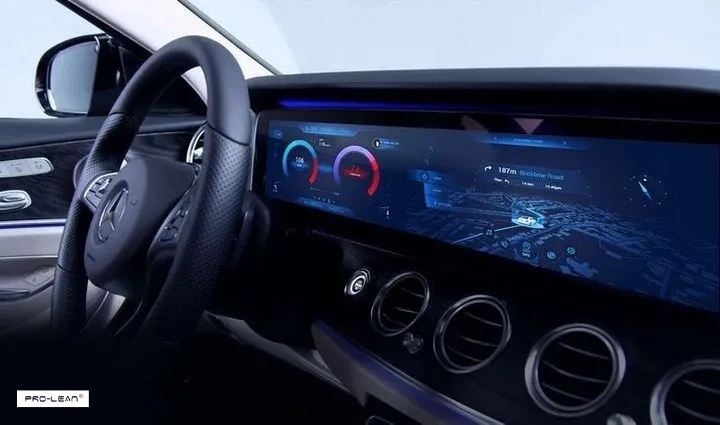
Car Dashboard Assembly Line
The dashboard assembly connects various components to functional units. It can be used for special features or motor vehicle assembly parts.
Electronic components, including displays, control, and circuit boards, are installed and are associated with a wiring harness. The automatic system verifies the electrical connection and functionality.
The main dashboard structure is integrated with supporting components, including air ducts, reinforcement brackets, and mounting points. Verify the quality check-up assembly during the procedure.
The final assembly installs the completed dashboard in the vehicle. The exact position ensures an appropriate fit and task. At PROLEANTECH, we create accurate components that provide a reliable dashboard assembly.
Quality Control and Testing
The dashboards go through careful tests to ensure that they work well and are safe. This involves testing their electronics, closely looking at the materials from which they are made, and determining if they last longer with use.
To see how the dashboard handles different weather, they are kept in very hot and icy places. This ensures that they do not matter to that climate. They also test how the material catches when it remains in the sun for a long time.
To ensure that dashboards are safe, they test where things kill them. It checks if they can withstand the force of an accident and cannot cause any danger. The electronic parts of the dashboard are also tested to ensure that they do not interfere with other electronic devices nearby.
Looking for more information on automotive systems? Read our guide to Car Suspension Systems: Functions, Parts, and Machining Ways.
Dashboard Maintenance Tips
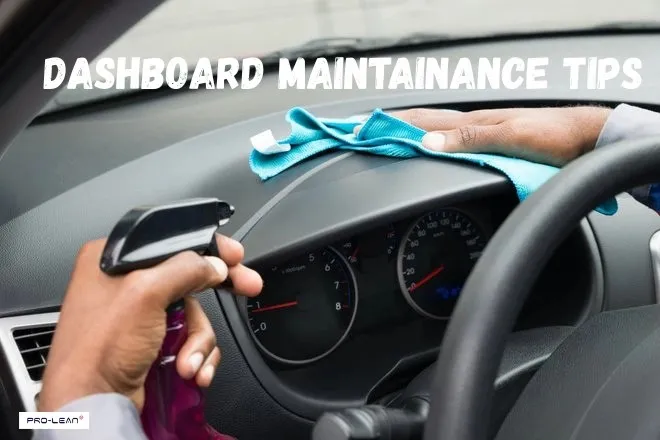
Car Dashboard Cleaning and Maintenance Tips
Proper maintenance extends dashboard life and preserves appearance. Simple care routines prevent common issues and deterioration.
Cleaning Techniques
Different dashboard materials require specific cleaning approaches. Using the wrong products can cause damage or deterioration. Here are some cleaning tips you must follow;
- Use automotive cleaners for vinyl and plastic surfaces.
- Don’t use cleaners that contain alcohol or ammonia, as they can result in drying and cracking over time.
- Leather dashboards require special conditioners to prevent drying.
- Microfiber cloths work best for cleaning without scratching surfaces.
Preventing Sun Damage
Strong sunlight can make things inside your car, such as the dashboard, fade and become damaged. This is a significant problem because the dashboard always gets sunlight through the windshield.
However, you can help prevent this loss. Putting a film on the windows of your car makes that intense light makes that intense light. Also, when you park your car, it can give it even more protection by using a cover on the dashboard. By doing these easy things, your dashboard can be made to last a long time.
Try to park your car where there is a shadow. When you park for a while, insert a sunshade inside your windshield. Now, put a special cleaner on your dashboard and keep the material in good shape.
For more information on automotive components, check out our guides on Camshaft Basics: Types, Materials, and Functions and Complete Guide to Crankshaft Components and Costs.
Dashboard Technology Trends
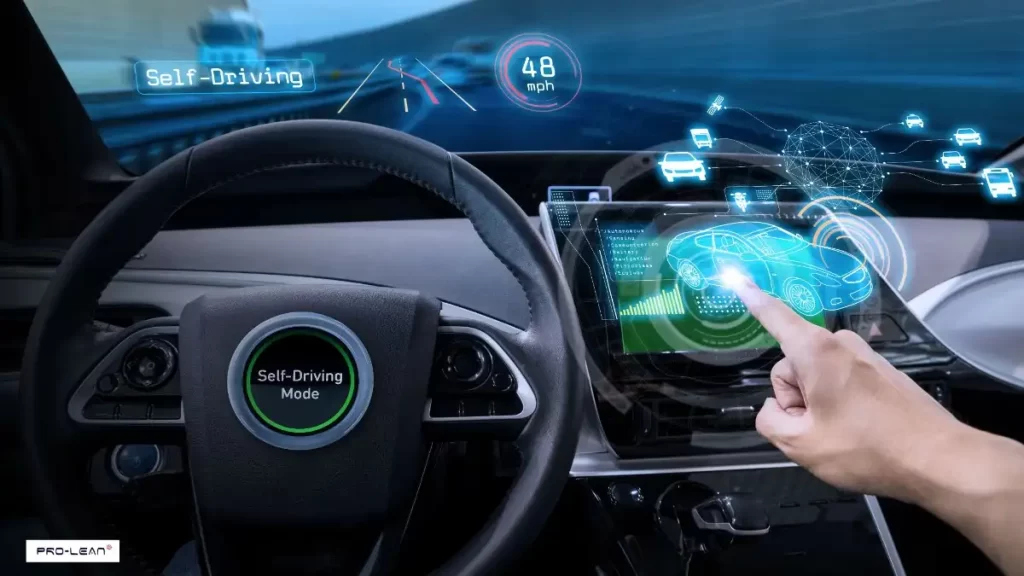
Future Car Dashboard Technology Trends
Automotive dashboards continue evolving with new technologies. These innovations improve functionality, safety, and user experience.
Connected Dashboards
Modern car screens now often link to the Internet. This allows them to show the latest information and is checked from a distance. When you are driving, it makes these connections easier and safer.
Cloud-related systems can tell you about traffic and weather. They can suggest better ways to go based on what is happening now. Some can also quickly check how your car is looking for problems from a distance.
When you connect your phone, the car screen can do even more. Your phone apps may look right on the dashboard, so you can use what you know by paying attention to driving.
Augmented Reality Displays
Augmented reality is like adding see-through computer images to what you already see in the real world. This new tech is changing how the screens in cars show you information.
Newer windshield displays can put navigation directions right on the road you’re looking at. They can also point out dangers and give you helpful driving tips. This way, drivers can keep looking at the road while still seeing important information.
Some systems use cameras to help you see better when it’s hard to see, like in bad weather. They can make the lines on the road and the edges of the road easier to see. This technology is getting better very quickly, with screens that show things more clearly.
Are you interested in understanding precision manufacturing more? Learn about CNC Machining Explained in our detailed guide.
Conclusion
The front part of the driver in a car is the dashboard. This helps the driver to know what the car is doing. By looking at the signals and knowing what the parts do, driving is made safe. It also helps to keep the car in good shape. The dashboard tells us important things about the car. Taking care of them makes them work better.
Cars are getting more modern, so they will also have a dashboard. Soon, they may have things that connect to the Internet, show images on the windshield, and help with self-driving. These new things will make driving better and safer than before.
For all your precision automotive component manufacturing needs, Contact us now or get an Instant Quote for your project. Learn more about our CNC Machining Services to see how ProleanTech can support your automotive manufacturing requirements.
Frequently Asked Questions
Q1. What is the Dashboard of a Car Called?
The part in a car called the dashboard is also known as the instrument panel or just the dash. The name “dashboard” comes from the old days of horse carriages. These carriages had a board at the front to stop mud kicked up by the horses from getting on the driver.
Now, cars have these panels too. But instead of blocking mud, they hold vital information. You can see things like how fast you’re going and how much fuel you have left on this panel.
Sometimes, people who work with cars use a longer name for this whole setup. They might call it the “instrument panel assembly.” This includes everything you see, like the outside look and the parts that hold it all together inside.
Q2. How are Car Dashboards Manufactured?
Car dashboards are made by first using hot liquid plastic to form the main shape. Then, they put in the electronic parts and buttons that you use.
To do this, they first plan how it will look, pick the right materials, mold the plastic, put all the parts together, and then check to make sure it’s made correctly.
ProleanTech helps make very exact parts for these important dashboard pieces. We are good at making sure these parts are made the right way for cars.

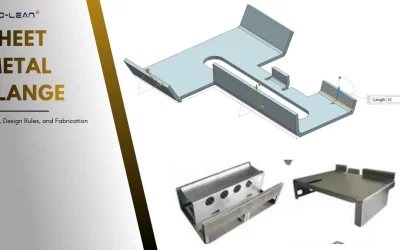
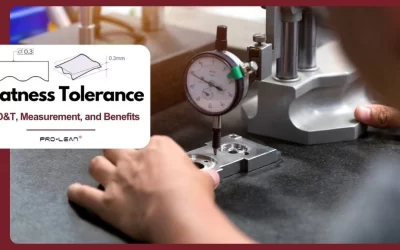
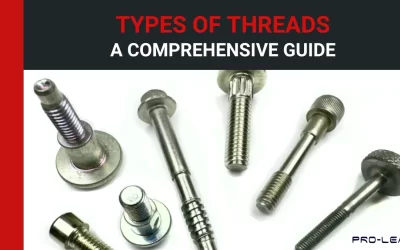
0 Comments